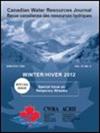历史气候变化下不规范东坡河流的水文行为
IF 0.9
4区 环境科学与生态学
Q3 WATER RESOURCES
引用次数: 1
摘要
摘要Elbow河是一条东部斜坡河流,其源头位于阿尔伯塔省落基山脉,其主要最终用途是卡尔加里市的重要水源。其流域的过多降水主要以雪的形式下降,并以积雪的形式积累,直到春季融化。从5月到10月,降水量主要以降雨形式下降。卡尔加里供水水库上方的河流不受管制,其相对未开发的流域使其成为研究气候变化对河流水文潜在影响的理想场所。对该流域的可用历史水文气象数据(1967年至2015年)进行了评估,以研究其在气候变化下的水文行为。分析显示,流量和降水变量都有显著的上升趋势,尤其是从1979年到2015年。在其他东坡河流中,没有观察到年流量和年最大日流量(AM流量)的显著增加,以及AM流量后来的季节性出现。尽管这些变化可能会缓解预测的供水短缺,但也可能增加洪水的规模。分析还显示,在高流量季节(5月至10月),三个地理面积大致相等的子流域产生了不同的流量。上游流域贡献最大(~68%),其次是中部流域(~26%)和下游流域(~6%)。极端高流量事件(即>90%AM流量)与高降雨量事件密切相关,但与积雪损失(或融化)无关。中等AM流量与高流量季节前的累积积雪损失和AM流量前的累积前期降水量呈正相关,表明前期土壤水分条件可能发挥作用。因此,气候变化对这条东坡河水文影响的预测应考虑气象变量和流域水分条件的影响。本文章由计算机程序翻译,如有差异,请以英文原文为准。
Hydrological behaviour of an unregulated eastern slope river under changing historical climate
Abstract The Elbow River is an eastern slope river with headwaters in the Rocky Mountains in Alberta whose major end-use is a critical source of municipal water for Calgary. Overwinter precipitation in its watershed falls primarily as snow and accumulates as snowpack until spring melt. Precipitation falls mainly as rain from May until October. The river is unregulated above Calgary’s water supply reservoir, and its relatively undeveloped watershed makes it ideal for examining potential climate change impacts on river hydrology. Available historical hydrometeorological data (1967 to 2015) from the basin were assessed to study its hydrological behaviour under a changing climate. The analysis showed significant upward trends in both flow and precipitation variables, especially from 1979 to 2015. Significant increases in both annual flow volume and annual maximum daily flow (AM-flow), and later seasonal occurrence of AM-flow, were not observed in other eastern slope rivers. Although these changes could attenuate predicted water supply shortages, they could also potentially increase flood magnitudes. The analysis also revealed that three sub-watersheds, which are approximately equal in geographic area, contributed differing flow volumes during the high-flow season (May to October). The upper watershed contributed most (∼68%), followed by the middle (∼26%) and lower (∼6%) watersheds, on average. Extreme high-flow events (ie >90th percentile AM-flow) were strongly related to high rainfall events, but not significantly related to snowpack loss (or melt). Moderate AM-flows were positively related to both the cumulative snowpack loss before the high-flow season and the cumulative antecedent precipitation prior to the AM-flow, suggesting that the antecedent soil moisture conditions could play a role. Predictions of climate change impacts on this eastern slope river’s hydrology should thus consider the effects of meteorological variables and the moisture conditions of the watershed.
求助全文
通过发布文献求助,成功后即可免费获取论文全文。
去求助
来源期刊

Canadian Water Resources Journal
WATER RESOURCES-
CiteScore
2.90
自引率
5.90%
发文量
17
审稿时长
>12 weeks
期刊介绍:
The Canadian Water Resources Journal accepts manuscripts in English or French and publishes abstracts in both official languages. Preference is given to manuscripts focusing on science and policy aspects of Canadian water management. Specifically, manuscripts should stimulate public awareness and understanding of Canada''s water resources, encourage recognition of the high priority of water as a resource, and provide new or increased knowledge on some aspect of Canada''s water.
The Canadian Water Resources Journal was first published in the fall of 1976 and it has grown in stature to be recognized as a quality and important publication in the water resources field.
 求助内容:
求助内容: 应助结果提醒方式:
应助结果提醒方式:


